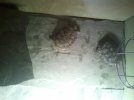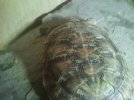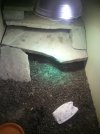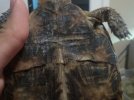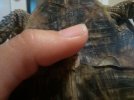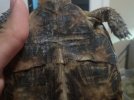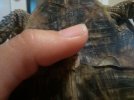- Joined
- May 18, 2012
- Messages
- 14
Hello all,
I am newish to the pancake tortoise world (have had two sulcatas for alittle while now and am a reptile/elephant keeper). I have two and I want to know what I need to correct since personality wise and physically they seem very different from the torts I have experience with. Our enclosure is about 2ish feet by 4feet or so with a three layer climbing and hiding structure on one side made of rock. The substrate consists of 50-50ish combo organic garden soil and play sand. We have a Exo terra MVB running for them (used to have it on the side away from the climbing structure but they never sat under it so I moved it towards the center of the enclosure) There is also a LED daylight bulb for extra lighting and color. At night I run a CHE but I'm thinking from my reading that this might not be needed at this point. My temps range from high 90s very low 100s under the MVB with 80-85 being average throughout the exhibit and spots droping to 78-79 on the bottom level of the climbing structure on the substrate all during the day. At night under the CHE the temp is around 80 which seems pretty high after doing some reading. They have a dish to soak in and I soak them once or twice a week for about 10-15min in a seperate dish (they are about 4.5in SCL). Other than that there isnt much humidity and the substrate is dry at this point. I feed them similar to a sulcata with the majority of the diet being grasses and hay and then a "green" portion consisting of pricky pear pad, grape leaves, bristely oax tongue, carrot greens, mustard greens, collard greens, rose petals, and dandylion (when I can find a safe source). I have been supplementing with calcium without d3 once or twice a week since they don't seem to munch on their cuttlefish bone like the sulcatas. The problems we are having. They seem to just sleep out in the open on the rock landings to the climbing structure alot. Our female seemed lethargic and our male was all over the place and now they have seemed to flip flop in activity level. Our plastrons are soft (I dont know how soft is normal). Our females scutes on her carapace are concaved inward a bit (Again in almost all torts this is a bad thing but I wasn't sure in pancakes). Also our female does seem to "yawn" at least once or twice a day however her eyes and nostrils are clear without any discharge. Please let me know whenever anyone has time what is normal for these guys and what husbandry changes I need to make. Oh also we are in southern oregon and have a safe outdoor enclosure that our torts share (not in it at the same time between the different species but still use the same area as they swap in and out) we have recently the past couple weeks or so let them out for an hour or so a couple times a week when temps have been above 75ish. Thanks for everyones help
I am newish to the pancake tortoise world (have had two sulcatas for alittle while now and am a reptile/elephant keeper). I have two and I want to know what I need to correct since personality wise and physically they seem very different from the torts I have experience with. Our enclosure is about 2ish feet by 4feet or so with a three layer climbing and hiding structure on one side made of rock. The substrate consists of 50-50ish combo organic garden soil and play sand. We have a Exo terra MVB running for them (used to have it on the side away from the climbing structure but they never sat under it so I moved it towards the center of the enclosure) There is also a LED daylight bulb for extra lighting and color. At night I run a CHE but I'm thinking from my reading that this might not be needed at this point. My temps range from high 90s very low 100s under the MVB with 80-85 being average throughout the exhibit and spots droping to 78-79 on the bottom level of the climbing structure on the substrate all during the day. At night under the CHE the temp is around 80 which seems pretty high after doing some reading. They have a dish to soak in and I soak them once or twice a week for about 10-15min in a seperate dish (they are about 4.5in SCL). Other than that there isnt much humidity and the substrate is dry at this point. I feed them similar to a sulcata with the majority of the diet being grasses and hay and then a "green" portion consisting of pricky pear pad, grape leaves, bristely oax tongue, carrot greens, mustard greens, collard greens, rose petals, and dandylion (when I can find a safe source). I have been supplementing with calcium without d3 once or twice a week since they don't seem to munch on their cuttlefish bone like the sulcatas. The problems we are having. They seem to just sleep out in the open on the rock landings to the climbing structure alot. Our female seemed lethargic and our male was all over the place and now they have seemed to flip flop in activity level. Our plastrons are soft (I dont know how soft is normal). Our females scutes on her carapace are concaved inward a bit (Again in almost all torts this is a bad thing but I wasn't sure in pancakes). Also our female does seem to "yawn" at least once or twice a day however her eyes and nostrils are clear without any discharge. Please let me know whenever anyone has time what is normal for these guys and what husbandry changes I need to make. Oh also we are in southern oregon and have a safe outdoor enclosure that our torts share (not in it at the same time between the different species but still use the same area as they swap in and out) we have recently the past couple weeks or so let them out for an hour or so a couple times a week when temps have been above 75ish. Thanks for everyones help

